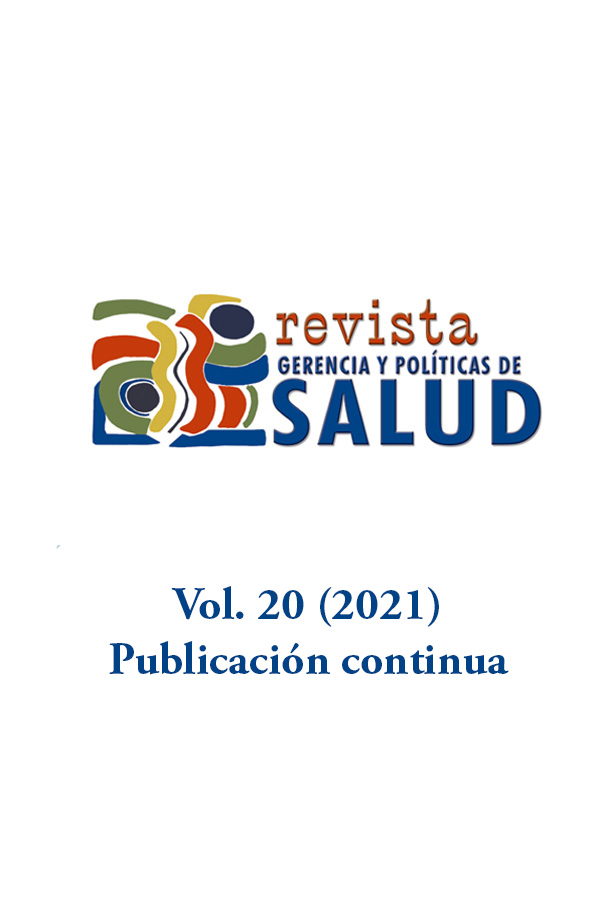Resumen
Introducción. Enfermedades como la diabetes mellitus y la hipertensión arterial son cada vez más frecuentes a nivel mundial con importantes costos sociales asociados. Objetivo. Evaluar la prevalencia de hipertensión y diabetes en los trabajadores de la plaza de mercado de un municipio de Antioquia, Colombia y los factores de riesgo asociados. Metodología. Se llevó a cabo un estudio observacional de tipo transversal analítico en un censo de 194 trabajadores de los cuales 152 tuvieron evaluación médico-laboral y encuesta de datos sociodemográficos y laborales. Se hizo una estandarización previa de los evaluadores con control de calidad del dato y análisis univariado y bivariado de los datos con IC 95%. Resultados. El 57% era mujer, 73,4% ganaba menos de un salario mínimo mensual legal vigente, 65,8% laboraba entre 9 y 12 horas y 11,9% entre 13 y 18 horas al día. El 62,4% no realizaba actividad física y 67,0% prefería los alimentos fritos. Un 20,9% tenía hipertensión arterial y se asoció con el estado civil, edad, antigüedad en el oficio, presión sistólica al momento de la evaluación, antecedente familiar y sexo. Un 9,2% tenía diabetes mellitus y esto se asoció con el estado civil, edad y presión sistólica al momento de la evaluación. Conclusiones. Se encuentra una población trabajadora informal con alta carga de enfermedad y de factores de riesgo que evidencian la necesidad de políticas públicas y programas enfocados específicamente en sus riesgos y estilos de vida.
Jamison D, Etienne C. Prefacio. Las dimensiones económicas de las enfermedades no transmisibles en América Latina y el Caribe. Washington DC: OPS; 2017. p.V-VI. http://iris.paho.org/xmlui/bitstream/handle/123456789/33994/9789275319055-spa.pdf?sequence=1&isAllowed=y
Organización Mundial de la Salud (OMS). Informe sobre la situación mundial de las enfermedades no transmisibles. Ginebra; 2014. http://apps.who.int/iris/bitstream/handle/10665/149296/WHO_NMH_ NVI_15.1_spa.pdf;jsessionid=B2E3BF92C4778B75162AD8474655B658?sequence=1
World Health Organization (WHO). Causes of death 2008: Data sources and methods. Geneva; 2011. https://www.who.int/healthinfo/global_burden_disease/cod_2008_sources_methods.pdf
Lim SS, Vos T, Flaxman AD, Danaei G, Shibuya K, Adair-Rohani H, et al. A comparative risk assessment of burden of disease and injury attributable to 67 risk factors and risk factor clusters in 21 regions, 1990-2010: A systematic analysis for the Global Burden of Disease Study 2010. Lancet. 2012 Dec 15;380(9859):2224-2260. http://www.ncbi.nlm.nih.gov/pubmed/23245609
World Health Organization (WHO). Global status report on noncommunicable disease 2010. Geneva; 2011. http://www.who.int/about/licensing/copyright_form/en/index.html
World Health Organization (WHO). A Global Brief on Hypertension. Geneva; 2013. www.who.int/about/licensing/copyright_form/en/index.html
Farkouh ME, Rayfield EJ, Fuster V. Diabetes and cardiovascular disease. In: Fuster V, Harrington R, Narula J, Eapen Z (eds). Hurst’s The Heart, 14e. New York: McGraw-Hill Education; 2017. http://accessmedicine.mhmedical.com/content.aspx?aid=1154846897
Blanco A, Jacoby E, Monteiro M, Caixeta R, Smith B, Grajeda R, et al. Factores de riesgo en las Américas: orígenes de la carga. En: Las dimensiones económicas de las enfermedades no transmisibles en América Latina y el Caribe. Washington DC: OPS; 2017. p. 25-33. http://iris.paho.org/xmlui/bitstream/handle/123456789/33994/9789275319055-spa.pdf?sequence=1&isAllowed=y
Ministerio de Salud y Protección Social (MinSalud). Análisis de Situación de Salud Colombia. Bogotá; 2016. https://www.minsalud.gov.co/sites/rid/Lists/BibliotecaDigital/RIDE/VS/ED/PSP/asis-colombia-2016.pdf
World Health Organization (WHO). Global Health Observatory data repository. World Health Organization; 2018. http://apps.who.int/gho/data/node.home
Lund F. Social protection and the informal economy: Linkages and good practices for poverty reduction and empowerment. In: Promoting pro-poor growth: Social protection. Geneva: OECD; 2009. p.69-88. http://www.oecd.org/development/povertyreduction/43280700.pdf
Vélez C, Escobar M, Pico M. Determinantes sociales de la salud y el trabajo informal. Rev Costarr Salud Pública. 2013;22(2):156-162. https://www.researchgate.net/publication/263474018_Determinantes_sociales_de_la_salud_y_el_trabajo_informal
Gómez-Palencia IP, Castillo-Ávila IY, Banquez-Salas AP, Castro-Ortega AJ, Lara-Escarlate HR. Condiciones de trabajo y salud de vendedores informales estacionarios del mercado de Bazurto, en Cartagena. Rev Salud Pública. 2012;14:448-459. https://www.scielosp.org/article/rsap/2012.v14n3/448-459/
Briceño L, Pinzón AM. Trabajo infantil en una plaza de mercado de Bogotá, Colombia. Rev Salud Pública. 2005;7(1):26-38. http://www.scielo.org.co/pdf/rsap/v7n1/v7n1a3.pdf
Garzón-Duque MO, Cardona-Arango MD, Rodríguez-Ospina FL, Segura-Cardona AM. Informalidad y vulnerabilidad laboral: aplicación en vendedores con empleos de subsistencia. Rev Saude Publica. 2017;51:1-17. https://scielosp.org/pdf/rsp/2017.v51/89/es
International Labour Organization. Informal economy. 2018. http://www.ilo.org/ilostat-files/Documents/description_IFL_EN.pdf
Aschner P. Epidemiología de la diabetes en Colombia. Av en Diabetol. 2010;26(2):71-134. https://linkinghub.elsevier.com/retrieve/pii/S1134323010620054
American Diabetes Association. Obesity management for the treatment of type 2 diabetes. Diabetes Care. 2016;39(Suppl 1):S47-S51. http://www.ncbi.nlm.nih.gov/pubmed/26696681
American Diabetes Association. Lifestyle management: standards of medical care in diabetes. Diabetes Care. 2018 Jan;41(Suppl 1):S38-S50. http://www.ncbi.nlm.nih.gov/pubmed/29222375
Organización Panamericana de la Salud (OPS). Los impuestos a los refrescos y a las bebidas azucaradas como medida de salud pública. https://www.paho.org/mex/index.php?option=com_content&view=article&id=627:los-impuestos-refrescos-bebidas-azucaradas-medida-salud-publica&Itemid=499
Álvarez-Sánchez C, Contento I, Jiménez-Aguilar A, Koch P, Gray HL, Guerra LA, et al. Does the Mexican sugar-sweetened beverage tax have a signaling effect? ENSANUT 2016. PLoS One. 2018 Aug 22;13(8):e0199337. https://doi.org/10.1371/journal.pone.0199337
Colchero MA, Salgado JC, Unar-Munguía M, Molina M, Ng S, Rivera-Dommarco JA. Changes in prices after an excise tax to sweetened sugar beverages was implemented in Mexico: Evidence from urban Areas. Nugent RA. PLoS One. 2015 Dec 14;10(12):e0144408. https://dx.plos.org/10.1371/journal.pone.0144408
Organización Panamericana de la Salud (OPS). Estrategia para la prevención y el control de las enfermedades no transmisibles, 2012-2025. Washington DC; 2012. https://www.paho.org/hq/dmdocuments/2012/CSP28-9-s.pdf
Marmot MG. Status syndrome. JAMA. 2006;296(4):395-396. https://doi.org/10.1001/jama.296.4.395
International Labour Organization. Resolution concerning decent work and the informal economy; 2002. https://www.ilo.org/public/english/standards/relm/ilc/ilc90/pdf/pr-25res.pdf
Marmot M. Status syndrome: A challenge to medicine. JAMA. 2006;295(11):1304-1307. http://dx.doi.org/10.1001/jama.295.11.1304

Esta obra está bajo una licencia internacional Creative Commons Atribución 4.0.
Derechos de autor 2021 Daniel Vasquez, María Osley Garzón-Duque, PhD



